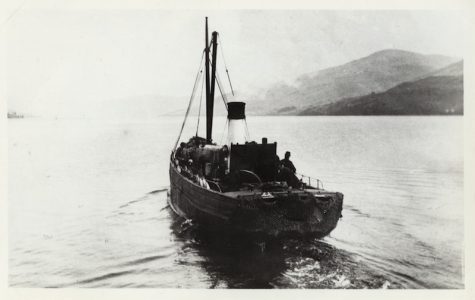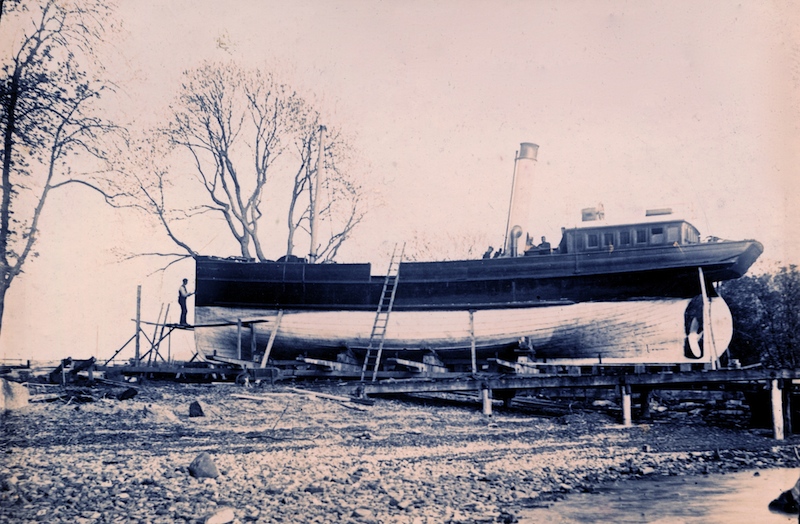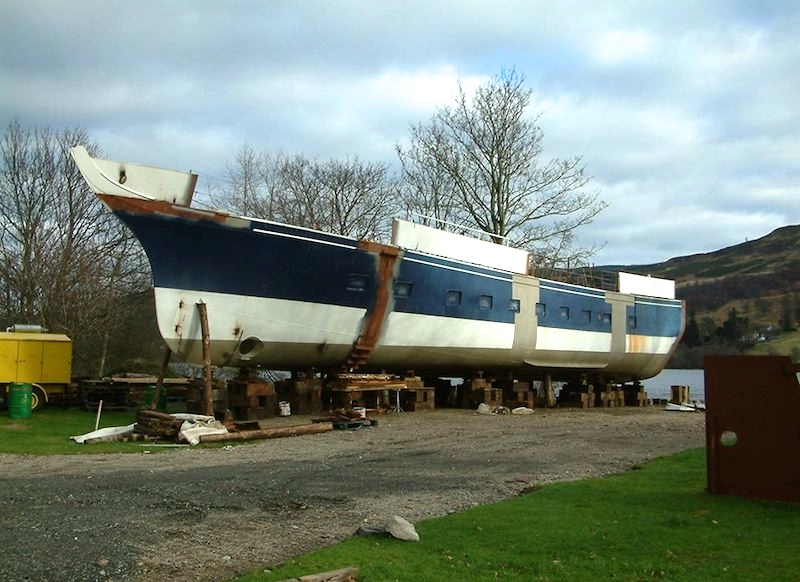
Gone but not forgotten: Spirit of the Tay in 2004 on the shore of Loch Tay at Dalerb, not far from Kenmore. The incomplete vessel has now been removed and presumably scrapped. Copyright Stuart Cameron
Stuart Cameron investigates the history of steamship sailings on Loch Tay and bemoans the unfulfilled potential of what seemed a promising project to revive them.
Although I have some distant family connections with the area around Loch Tay and I was aware that a few excursion steamers had been operated along its length in the years prior to the Second World War, I had not given much thought or attention to the loch or its steamers until the extraordinary and wholly unexpected announcement at the start of the 21st century that a new enterprise, the Loch Tay Steam Packet Company, had formed to re-instate steamer excursions on Scotland’s sixth largest freshwater loch.
Had the plans involved a new or even second hand motor vessel the proposal would have been interesting enough, but this was a much more ambitious project in that it involved the construction of a brand new steam ship, based on the design of a steamer that had sailed on another Scottish loch in Victorian times. While the vessel and the boiler would be new, the engine was pre-existing, having been built by a well known firm in Great Yarmouth when that port was home to a vast number of steam powered trawlers.
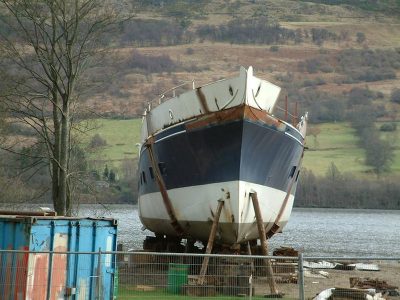
The hull of Spirit of the Tay, stranded on her temporary lochside building berth. Copyright Stuart Cameron
Interest increased further when it was announced that the century-old firm of Ferguson Shipbuilders had won the contract to fabricate the sections of the vessel at their Newark Shipyard in Port Glasgow. Fergusons were also contracted to arrange to transport the sections by road to Dalerb, which is on the north shore of Loch Tay not far from Kenmore at its eastern end, and to assemble the vessel there on a temporary building berth from which it would be launched into the loch.
The berth was to be rudimentary, for the purpose of assembling the vessel and getting the hull afloat, and there was no indication at the time of how the vessel would be taken out of the water for periodic survey and maintenance.
There was limited information on the services that would be offered but enough to indicate that the new company was targeting the combined ‘dine-and-cruise’ market. The upper passenger deck of the vessel was to be mainly open, with no internal accommodation apart from a toilet for the disabled, and, therefore, ideal for viewing the glorious scenery around Loch Tay. The lower passenger deck was mainly to be given over to a sumptuous dining saloon and attendant galley.
The engine, boiler and other machinery would be located aft on the lower deck. From rudimentary, small-scale drawings of the vessel issued at the time, it seemed that the vessel would be divided into three discrete compartments at the lower level subdivided by two transverse watertight bulkheads, one at the forward end of the dining saloon, the other between the engine space and the boiler room. The engine was in the same compartment as the saloon so, presumably, passengers may have had the opportunity to observe it in motion. Given the size and location of the rectangular saloon windows, it appeared that the lower passenger deck would be below water level, at least amidships. There was no visible indication of longitudinal sub-division at that level.
The Loch Tay Steam Packet Company announced that it was planned for the vessel to be launched into the loch during 2005 when she would be named Spirit of the Tay, taking up service the following year. [See below for the outcome of this project]
Steamers on Scottish Lochs
While steamships were a fairly regular sight on the many sea lochs along Scotland’s western coastline until railways and roads penetrated the rugged terrain making overland journeys easier, the same could not be said for inland lochs. Indeed, with one notable exception, it could be argued that it was only with the coming of adequate railway and road services that there was sufficient business to justify building vessels for the inland lochs.
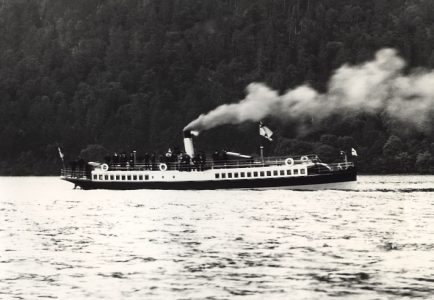
Lady of the Lake gave excursions on Loch Tay from the Victorian era until the 1920s. Copyright CRSC Archive Collection
Even so, the number of inland lochs that were actually provided with steamer services just managed to exceed single figures. These were: Loch Lomond, Loch Katrine, the Lake of Menteith, Loch Eck, Loch Awe, Loch Shiel, Loch Arkaig, Loch Maree, Loch Treig, Loch Tay, Loch Earn, Loch Ossian, Loch Rannoch and Lanark Loch. Of course, in addition to these there was Loch Ness and the others that form parts of Telford’s great Caledonian Canal but, to some extent, sailings on these could be regarded as an extension of the coastal services.
Steamer sailings on inland Scottish lochs really started when the innovative engineer David Napier, the man who built the boiler to provide the energy for John Robertson’s engine in Henry Bell’s pioneering PS Comet, took his own steamer, PS Marion, up the River Leven into Loch Lomond in 1818 (or 1817, depending on which source of information is consulted). The steamship era on Loch Lomond extended to 1981 and, hopefully, will resume some time in the not-too-distant future. Steamer excursions on Loch Katrine commenced with PS Gypsy in 1843 and are still operated over a century and a half later. By and large steamship operation on all of the other lochs named above had finished by the end of the 1930s, although a small steam launch, named Lady Rowena, revived steam on Loch Awe for a few years, commencing in 1986.
Loch Tay and its Steamers
Loch Tay is around 14 miles long from east to west but only 0.7 miles wide at its widest point. It is surrounded by generally gentle but beautiful natural scenery, dominated by the peak of Ben Lawers, which is 3,983 feet above sea level, the tenth highest peak in the British Isles.
Back in 1882 a company named the Loch Tay Steamboat Company was established by the then Earl of Breadalbane to operate steamer services on the Loch. The steamers operated between piers at Kenmore, Fearnan, Ardtalnaig, Ardeonaig, Lawers and Killin.
After 40 years the Caledonian Steam Packet Company took over responsibility for the services, operating them between 1922 and 1939. Five steamers operated on the Loch.
Three of them, Magpie, Sybilla and Carlotta, were primarily used for cargo carrying but the latter two could take some passengers and Carlotta was sometimes used as a private yacht by the Marquis of Breadalbane.
The principal passenger steamers were SS Lady of the Lake, built in 1882 by Anderson & Lyall of Govan (one of the lesser known Clyde shipbuilding firms) and SS Queen of the Lake, which was a product of the Ailsa Shipbuilding Company’s Ayr Shipyard (formerly McKnight’s yard). She was launched into the loch on 13 June 1907.
Magpie was lost in a storm in 1907, Carlotta was disposed in 1923 and Sybilla and Lady of the Lake were both scrapped at Kenmore in 1929, leaving only Queen of the Lake to soldier on for another 10 years. On the outbreak of World War Two in 1939 she was hauled up on the repair slipway at Kenmore where she remained until 1950, when she was broken up where she lay by the firm of J A A White of North Queensferry.
A Dream Lost
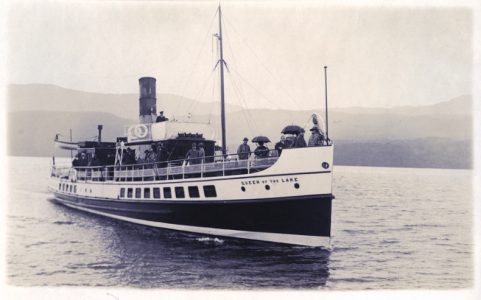
Queen of the Lake, which operated on Loch Tay from 1907 until 1939. Copyright CRSC Archive Collection
Following confirmation of the order for Spirit of the Tay, Ferguson Shipbuilders took up the task of fabricating the five sections of the new vessel’s hull at Port Glasgow during 2003 and by November of that year the sections had been transferred to Dalerb, followed by the funnel housing and the deck cabin to accommodate the toilet.
In general appearance the vessel was to resemble the steamer Rob Roy, which Alexander Denny, one of the Denny shipbuilding dynasty of Dumbarton, had built in 1855 at the Albert Shipyard for the Loch Lomond Steamboat Company. Subsequently, she transferred to the Loch Katrine Steamboat Company in 1859. Rob Roy was replaced by the current Loch Katrine steamer Sir Walter Scott in 1900, but was retained on the loch in reserve until 1908 when she was broken up.
Despite similarities in appearance to Rob Roy, Spirit of the Tay was not an exact copy. When I visited her at Dalerb in 2004 the forward four sections of the hull had already been welded together with only the stern section to be added. Although the minimal superstructure was still to be added and the hull was still to be painted at the section interphases, she was beginning to look impressive and I was enthused by the prospect of a first sail on her out in the loch a couple of years down the line. Strangely, though, I got an odd feeling that nothing much had been happening on the site for some time. I was unaware then that a serious disagreement was developing between the builders, the owners and the Maritime & Coastguard Agency.
By 2005 the dispute had come into the public domain. Work on the vessel had stopped. The owners claimed that the MCA had indicated to them that there was a problem regarding the welds that had been made to join the sections of the vessel. They further stated that they believed this was due to the inadequacy of the temporary building berth to support the weight of the vessel. The claims were rigorously disputed by the builders. Apparently the dispute rumbled on for the next 2-3 years. In May 2009, the Historic Ship Co Ltd (aka Loch Tay Steam Packet Company) was formally dissolved, and the unfinished vessel lay rusting on the loch side. We may never know the full story behind the failure of this bold project.
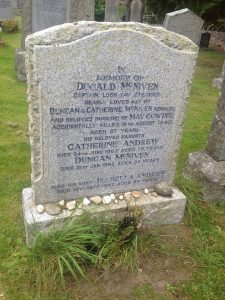 POSTSCRIPT, added by Stuart Cameron on 4 September 2017:
POSTSCRIPT, added by Stuart Cameron on 4 September 2017:
Almost 14 years have passed since construction of the new Loch Tay steamboat began, and I can now bring some closure to the story. Yesterday, 3 September 2017, I visited the assembly site where the partially completed vessel had lain since the early years of the the 21st century, following the dispute between the builders and owners. I can confirm that the incomplete vessel has now been removed (and presumably scrapped).
Curiously the ‘temporary’ security fence that had been constructed around the vessel during construction is all that remains to remind us of this ambitious, but ultimately unsuccessful, venture.
It may also be of interest that, during a short walk in the churchyard of Kenmore Parish Kirk, at the eastern end of Loch Tay yesterday afternoon, I came across the grave of one Dugald McNiven, described as the “Captain of the Loch Tay Steamer”, who was tragically killed in an accident in 1940 at the age of only 37 years.
There are no further details but I would suggest that Mr McNiven must have been the last Master of the last Loch Tay steamer, Queen of the Lake, which was withdrawn from service at the start of the Second World War and never resumed after the cessation of hostilities.
Since April 2017 Loch Tay Safaris have been operating cruises on Loch Tay with Iolaire, a 12-seater RIB. The cruises last for 90 minutes, cost £30 per person and run until November. Tel 01887 820071.
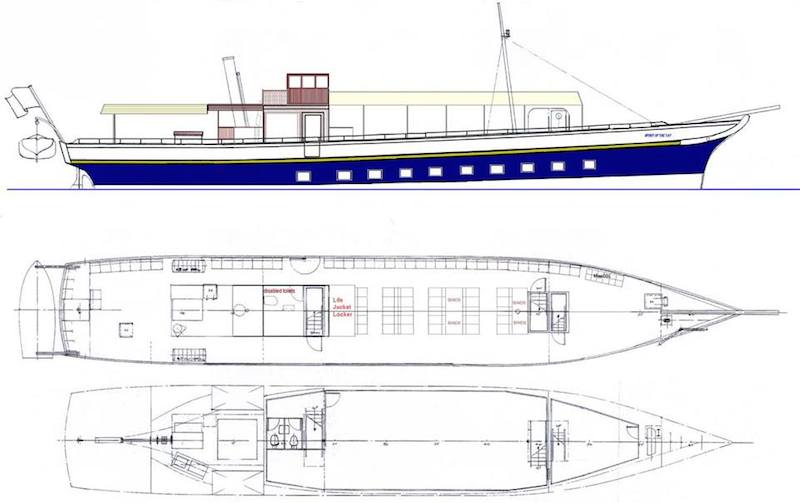
Conceptual design for the Loch Tay Steam Packet Company’s excursion steamer Spirit of the Tay. Reproduced courtesy of Stuart Cameron

Spirit of the Tay was modelled on the elegant mid 19th century steamer Rob Roy, built at Dumbarton and pictured here on Loch Katrine. After the introduction of Sir Walter Scott in 1900, Rob Roy survived a few years before being broken up in 1908. Copyright CRSC Archive Collection
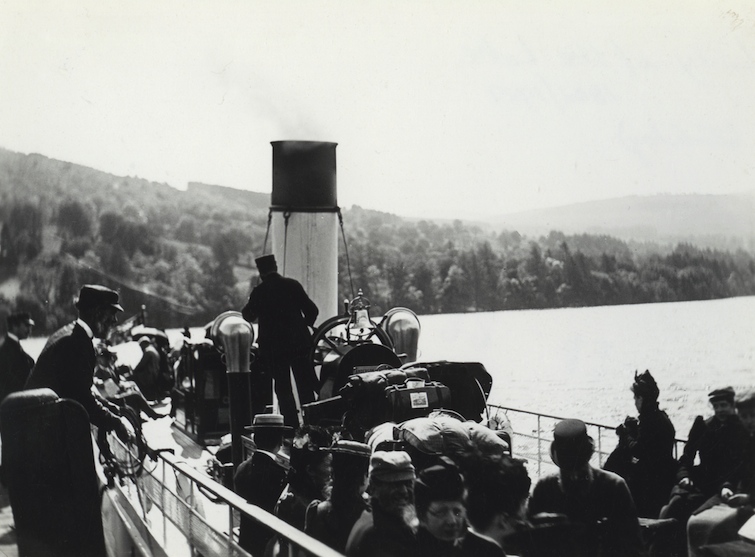
Period piece: Lady of the Lake preparing to depart for a cruise on Loch Tay c1912. Copyright CRSC Archive Collection
Catch up will all CRSC’s previous posts by clicking on News & Reports












